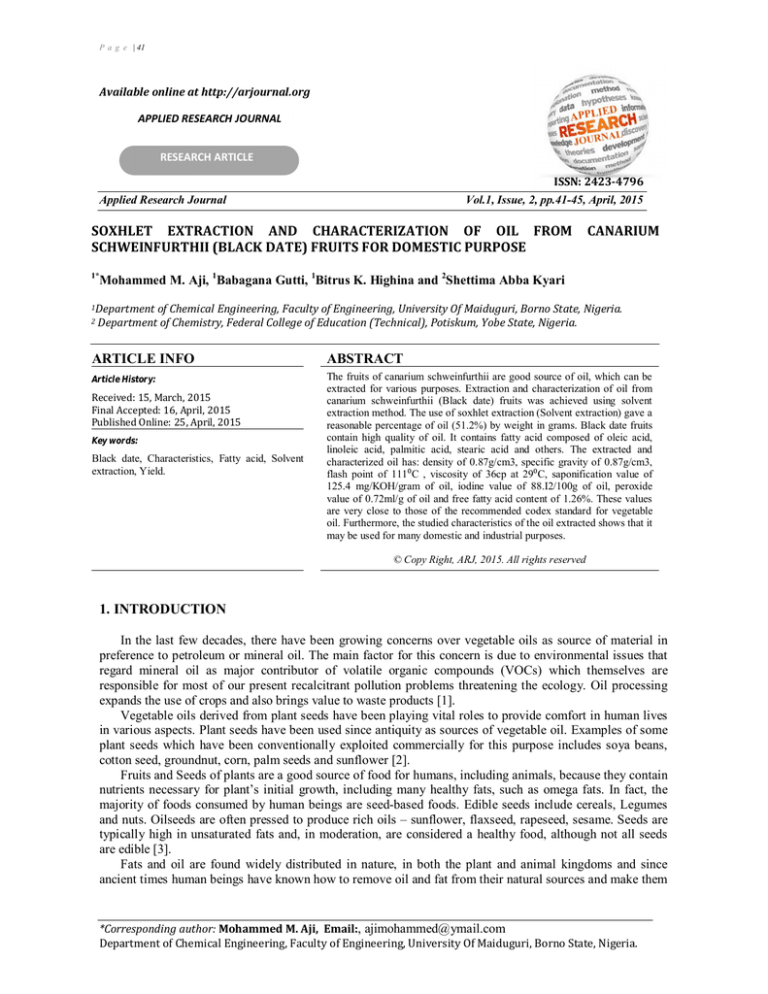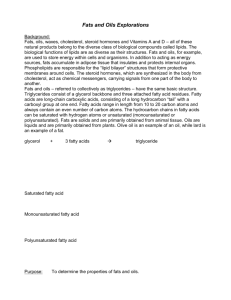
P a g e | 41
Available online at http://arjournal.org
APPLIED RESEARCH JOURNAL
RESEARCH ARTICLE
ISSN: 2423-4796
Applied Research Journal
Vol.1, Issue, 2, pp.41-45, April, 2015
SOXHLET EXTRACTION AND CHARACTERIZATION OF OIL FROM
SCHWEINFURTHII (BLACK DATE) FRUITS FOR DOMESTIC PURPOSE
CANARIUM
1*
Mohammed M. Aji, 1Babagana Gutti, 1Bitrus K. Highina and 2Shettima Abba Kyari
1Department
2
of Chemical Engineering, Faculty of Engineering, University Of Maiduguri, Borno State, Nigeria.
Department of Chemistry, Federal College of Education (Technical), Potiskum, Yobe State, Nigeria.
ARTICLE INFO
ABSTRACT
Article History:
The fruits of canarium schweinfurthii are good source of oil, which can be
extracted for various purposes. Extraction and characterization of oil from
canarium schweinfurthii (Black date) fruits was achieved using solvent
extraction method. The use of soxhlet extraction (Solvent extraction) gave a
reasonable percentage of oil (51.2%) by weight in grams. Black date fruits
contain high quality of oil. It contains fatty acid composed of oleic acid,
linoleic acid, palmitic acid, stearic acid and others. The extracted and
characterized oil has: density of 0.87g/cm3, specific gravity of 0.87g/cm3,
flash point of 111⁰C , viscosity of 36cp at 29⁰C, saponification value of
125.4 mg/KOH/gram of oil, iodine value of 88.I2/100g of oil, peroxide
value of 0.72ml/g of oil and free fatty acid content of 1.26%. These values
are very close to those of the recommended codex standard for vegetable
oil. Furthermore, the studied characteristics of the oil extracted shows that it
may be used for many domestic and industrial purposes.
Received: 15, March, 2015
Final Accepted: 16, April, 2015
Published Online: 25, April, 2015
Key words:
Black date, Characteristics, Fatty acid, Solvent
extraction, Yield.
© Copy Right, ARJ, 2015. All rights reserved
1. INTRODUCTION
In the last few decades, there have been growing concerns over vegetable oils as source of material in
preference to petroleum or mineral oil. The main factor for this concern is due to environmental issues that
regard mineral oil as major contributor of volatile organic compounds (VOCs) which themselves are
responsible for most of our present recalcitrant pollution problems threatening the ecology. Oil processing
expands the use of crops and also brings value to waste products [1].
Vegetable oils derived from plant seeds have been playing vital roles to provide comfort in human lives
in various aspects. Plant seeds have been used since antiquity as sources of vegetable oil. Examples of some
plant seeds which have been conventionally exploited commercially for this purpose includes soya beans,
cotton seed, groundnut, corn, palm seeds and sunflower [2].
Fruits and Seeds of plants are a good source of food for humans, including animals, because they contain
nutrients necessary for plant’s initial growth, including many healthy fats, such as omega fats. In fact, the
majority of foods consumed by human beings are seed-based foods. Edible seeds include cereals, Legumes
and nuts. Oilseeds are often pressed to produce rich oils – sunflower, flaxseed, rapeseed, sesame. Seeds are
typically high in unsaturated fats and, in moderation, are considered a healthy food, although not all seeds
are edible [3].
Fats and oil are found widely distributed in nature, in both the plant and animal kingdoms and since
ancient times human beings have known how to remove oil and fat from their natural sources and make them
*Corresponding author: Mohammed M. Aji, Email:, ajimohammed@ymail.com
Department of Chemical Engineering, Faculty of Engineering, University Of Maiduguri, Borno State, Nigeria.
P a g e | 42
Applied Research Journal
Vol.1, Issue, 2, pp.41-45, April, 2015
fit for their own uses [4]. Fats and oil are generally grouped as edible and inedible. They usually consist of
mixtures of the glycosides’ of various fatty acids [5].
Black date “Atili” also known as “Canarium schweinfurthii bursaraceae” is found in the kingdom
plantae, because it is made up of multicellular and non-motile organism and its leaves also contain
chlorophyll. It possesses vascular bundles placing it in the sub-kingdom tracheophyta. It falls under the super
division spermatophyte seed plants because it is a higher gymnosperm. The embryo bears two cotyledons
which places it in the class magnoliopsiodae dicotyledons. It also belongs to the sub-class rosidae because of
its polypetalous corolla [6].
In Nigeria, the fruit of the perennial tree plant is called “ube okpoko” in Igbo and “Atili” in Hausa. The
fruit is commonly found in large quantities in Pankshin area, Plateau state of Nigeria and is also produced in
similar quantities in other state of northern and south-eastern Nigeria, The fruit yields fats and oil [7].
The plant produces its fruits in the rainy season, usually between the months of April and September.
The flowers grow in clusters at the end of the twigs and are small and dark green in color, the fruit which are
of two varieties – long spirals and short round in shape develop from the flowers [8].
The general methods employed in obtaining fats and oil from oil bearing fruits is pressing, solvent
extraction and rendering. Obtaining crude oil and fats involve primarily physical changes or unit operations
but chemical changes conversions are concerned in the refining and further processing of such oils [9].
2. MATERIALS AND METHODS
2.1. Sample Collection and Preparation
Fresh and well ripe fruits of the black date (Atili) tree were purchased from local market at Jos, Plateau
state North-Central Nigeria. The fruits were sorted out to remove any dirt or foreign material present in them.
They were then washed in cold water to remove any dirt adhering to the surface of the fruits.
The separation of the pulp with the seed was done manually. After the separation, the pulp is pounded
into smaller particles and then dried.
2.2. Extraction of the Black date (Atili) oil
The grounded pulp was packed into the extraction chamber of the sox let extractor; while a solvent (NHexane) was poured into the round bottom flask of the extractor. The whole set-up was mounted on a
heating mantle at 65OC and allowed to reflux for about 8 hours.
The extract was filtered (to remove impurities) and evaporated using a rotary evaporator to isolate the
free flow lipid from the solvent. The extracted oil was further evaporated in an oven at 150°C to eliminate
any moisture and residue solvent that may be present. The weight of the oil produced and the residue were
measured to ascertain the percentage of the oil content.
2.3. Characterization of the Extracted Oil
In evaluating the physical and chemical characteristics of the extracted oil, the following parameters:
flash point, density, viscosity, specific gravity, saponification value, peroxide value, free fatty acid, acid
value and iodine value were determined by using standard methods.
2.4. Fatty Acid Composition
The fatty acid composition of the oil sample was analyzed using a Gas Chromatography (GC) of model
GC-2014, Shimadzu, Japan.
It is equipped with flame ionization detector (FID) and capillary column. The analysis of the sample was
carried out by injecting 1 µl of the extracted oil into the GC. The identification of the fatty acid was achieved
by retention times.
3. RESULTS AND DISCUSSION
1.3. Results
The results obtained from the experimental work of this project are presented in the Tables 1, 2, 3, and 4.
The Tables include results of the oil yield of the extraction process, composition of the free fatty acid, as well
as the physical and chemical characteristics of the extracted oil.
Mohammed M. Aji et al.
P a g e | 43
Table 1 Percentage Yield of the Black Date oil extracted
Time (hr)
Sieve Size (mm)
Volume of Solvent (ml)
Temperature (°C)
Mass of sample
Mass of Obtained Oil
% Oil Yield
1
1.18
200
65
18.36
4.16
22.65
2
1.18
200
65
18.36
6.25
34.04
3
1.18
200
65
18.36
7.8
42.80
4
1.18
200
65
18.36
8.28
45.10
5
1.18
200
65
18.36
8.65
47.11
6
1.18
200
65
18.36
8.84
48.12
7
1.18
200
65
18.36
9.14
49.80
8
1.18
200
65
18.36
9.40
51.20
9
1.18
200
65
18.36
9.40
51.20
10
1.18
200
65
18.36
9.40
51.20
Table 2 Fatty acid composition of the oil extracted.
Fatty Acid
Percentage Composition (%)
Oleic Acid
36
Linoleic Acid
28
Palmitic Acid
26
Stearic Acid
7
Others
3
Table 3 physical Characteristics of the Oil
Parameters
Color
Odour
State @ room tempreture
Specific Gravity
Density(g/cm³)
Flash point(°C)
Viscosity at 29°C (cp)
Analyzed
Dark Green
Agreeable
liquid
0.87
0.87
111
36
Table 4 Chemical Characteristics of the Oil
Parameters
Analysed
Saponification Value (Mg Kohg-¹ Of Oil)
125.4
Iodine Value (12 g 100 g-¹ of Oil)
88.32
Peroxide Value (Ml g-¹ of Oil)
0.72
Free Fatty Acid (%)
1.26
3.2. Discussion
The oil yield of the black date after eight hours of extraction time was found to be 51.2% as presented in
Table 1. From the results, it is clear that the percentage of oil yield increased from 22.26% to 49.80% as the
time of extraction increased from 1hr to 7hrs, but eight hours after it became constant. The oil yield which is
about 51.2% is high compared to the value reported in seeds of African star apple 12% [1] neem seeds 46%,
cotton seeds 24% and groundnut 46% [10]. It is also higher than the Balanite Aegyptica seeds 34.52% as
presented by [11]. This indicates that the black date may be good source of abundant oil for both domestic
and industrial purposes.
Table 2 shows the presence of four major fatty acids in the extracted oil. The main unsaturated fatty
acids are oleic acid (C18:1) and linoleic acid (C18:2), while the saturated fatty acids are palmitic (C16:0) and
stearic acid (C18:0). The percentages of the acids present in the oil is 36%, 28%, 26% and 7% respectively
as presented in Table 2. It is extremely important to realize that vegetable oils are mixtures of triglycerides
from various fatty acids. Fatty acid compositions are used to describe the specific nature of fatty acids
occurring in fats and oils [12]
Some selected physical characteristics of the oil extracted were presented in Table 3. The oil is a liquid
at room temperature, dark green in color, the odour is agreeable and not offensive, and it has a specific
gravity of 0.87 which shows that it’s less dense than water. This value is close to those obtained by [13] and
that of jatropa curcas oil as obtained by [14], which is similar to that of [15]. The oil has a viscosity of 36cp
P a g e | 44
Applied Research Journal
Vol.1, Issue, 2, pp.41-45, April, 2015
at 29oC, while the flash point of the oil was found to be 111oC. This shows that it can be used for both
domestic and industrial purposes.
The chemical characteristics of the extracted oil were presented in Table 4. The saponification value
obtained was 125.4 mg/KOH/g of oil. This is lower than sesame seeds (189 - 190mg/KOH/g) as reported by
[16]. However, according to [17] this saponification value is within the range of edible oils. The iodine value
88.32mg/100g is in close agreement with that obtained by [18]. Peroxide value is an index of rancidity, thus
the low peroxide value of the oil indicates a resistance of the oil to peroxidation during storage and the low
acid value is a reflection of the freshness and edibility. According to [19] the low acid and peroxide values
are indicators of the ability of the oil to resist hypolitic hydrolysis and oxidation deterioration.
4. CONCLUSION
The results of the oil yield and other physio-chemical analysis of the black date (Atili) oil compared
favourably with those of other conventional seed oils such as: groundnut, sesame, cotton, African star apple
and others. The oil yield 61.2% is high compared to some oil seeds. It has a viscosity of 36cp at 29oC, while
the flash point of the oil was found to be 111oC. This shows that it can be used for both domestic and
industrial purposes. The oil is composed of saturated and unsaturated fatty acids, the main unsaturated fatty
acids are oleic acid (C18:1) and linoleic acid (C18:2), while the saturated fatty acids are palmitic (C16:0) and
stearic acid (C18:0). The percentages of the acids present in the oil is 36%, 28%, 26% and 7% respectively
The low peroxide value of the oil indicates a resistance of the oil to peroxidation during storage and the low
acid value is a reflection of the freshness and edibility. Conclusively, the Atili oils have potential for use as
domestic and industrial oil.
5. REFERENCES
[1] Adebayo, S. E, Orhevba, B. A, Adeoye, P. A, Musa, J.J and Fase, O. J, 2012. Solvent Extraction and
Characterization of Oil from Africa Star Apple (Chrysophyllum Albidum) Seeds Vol.3 No. 2 Academic
Research International. Natural and Applied Sciences.
[2] Ochigbo, S.S. and Paiko, Y.B., 2011. Effects Of Solvent Blending On The Characteristics of Oils
Extracted From The Seeds of Chrysophyllum Albidium. International Journal of Science and Nature,
IJSN, 2(2): 352-358.
[3] ‘Vegetable Fats and Oils’ Wikipedia, 2011. Http://En.Wikipedia.Org/W/Index.Php? Title= Vegetable
Fats_And_Oils&Oldid=454235482"Http://En.Wikipedia.Org/Wiki/ Vegetable_ Fats and Oils.
[4] Eds L.V Cooks and C. Van Rede, 1997. Laboratory Handbook for Oil and Fat Analysis, Academic
Press London-New York.
[5] Danian, M.J. 1990. Principles of Food Chemistry, 2nd Edition, Van Nostrond Reinhold International
Company Limited, London, England. pp:37-38.
[6] Kochar, S.L, 1981. Tropical Crops: A Textbook of Economy Botany, Macmillan Publishers, New York,
pp: 214-217.
[7] Bander, A.E., 1990. Dictionary of Nutrition and Food Technology, 6th Edition, Butter Worth and
Company Publishers Limited, pp: 260.
[8] Fox, B.A and A.G Cameron, 1984. Food Science: A Chemistry Approach, 4th Edition, Holder and
Strong Ton Limited, London, Pp112-116.
[9] Person, D., 1991. The Chemical Analysis of Foods, 7th Edition, Church Livingstone Longman Group
Limited, pp: 493-499.
[10] Abdullahi, Y, Adeniyi, M.O and Ihekwuemere, C.A., 1991. Countdown to Senior Secondary
Certificate Exams in Agric Science. Nigeria: Evans Brothers. pp:150.
[11] Gutti, B., Bamidele S. S, Bugaje, I. M., 2012. Characterization and Composition of Balanite
Aegyptica Seed
Oil and Its Potential as Biodiesel Feedstock in Nigeria” Journal of Applied
Phytotechnology in Environmental Sanitation, 1(1): 29-35.
[12] Gerpen J. V, Shanks, B, Pruszko, R, Clements, D And Knothe, G., 2004. Biodiesel Production
Technology
Natural
Renewable
Energy
Laboratory,
Colorado.Available
@
Http://Www.Osti.Gov/Bridge
[13] Agu, H. O., Ukonze, J. A. and Uchola, N.O., 2008. Quality Characteristics of Crude and Refined
Atili Oils. Pakistan Journal of Nutrition 7(1): 27 – 30.
[14] Belewu, M.A., Adekola, F.A., Adebayo, G.B., Ameen, O.M., Muhammed, N.O., Olaniyan, A.M,
Adekola, O.F. and Musa, A.K., 2010. Physico-Chemical Characteristics of Oil and Bio-Diesel from
P a g e | 45
Mohammed M. Aji et al.
Nigerian and Indian Jatropha Curcas Seeds. International Journal of Biological and Chemical Science,
4(2): 524 – 529.
[15] Tint, T.K. And Mya, M., 2009. Production of Biodiesel from Jatropha Oil (Jatropha Curcas) In Pilot
Plant. World Academy of Science, Engineering and Technology. pp: 477 – 480.
[16] Mohammed, M. I. And Hamza, Z. U., 2008. Physicochemical Properties of Oil Extracts From
[17] Sesamum Indicum L. Seeds Grown In Jigawa State – Nigeria. Journal of Applied Science And
[18] Environmental Management, 12(2) : 99 – 101.
[19] Eromosele, I.C., Eromosele, C.O., Akintoye, A.O. and Komolafe, T.O., 1994. Characterization Of
[20] Oils and Chemical Analysis of the Seed of Wild Plants. Plant Food for Human Nutrition, 46:
[21] 361 – 365.
[22] Enweremadu, C.C. and Alamu, O.J., 2009. Development and Characterization of Biodiesel From
[23] Shea Nut Butter. International Journal of Agrophysics, Poland. 24:29-34.
[24] Akanni, M.S., Adekunle, A.S. And Oluyemi, E.A., 2005. Physico-Chemical Properties of Some
Nonconvetional Oilseeds. Journal of Food Technology. 3(2): 177 – 181.




